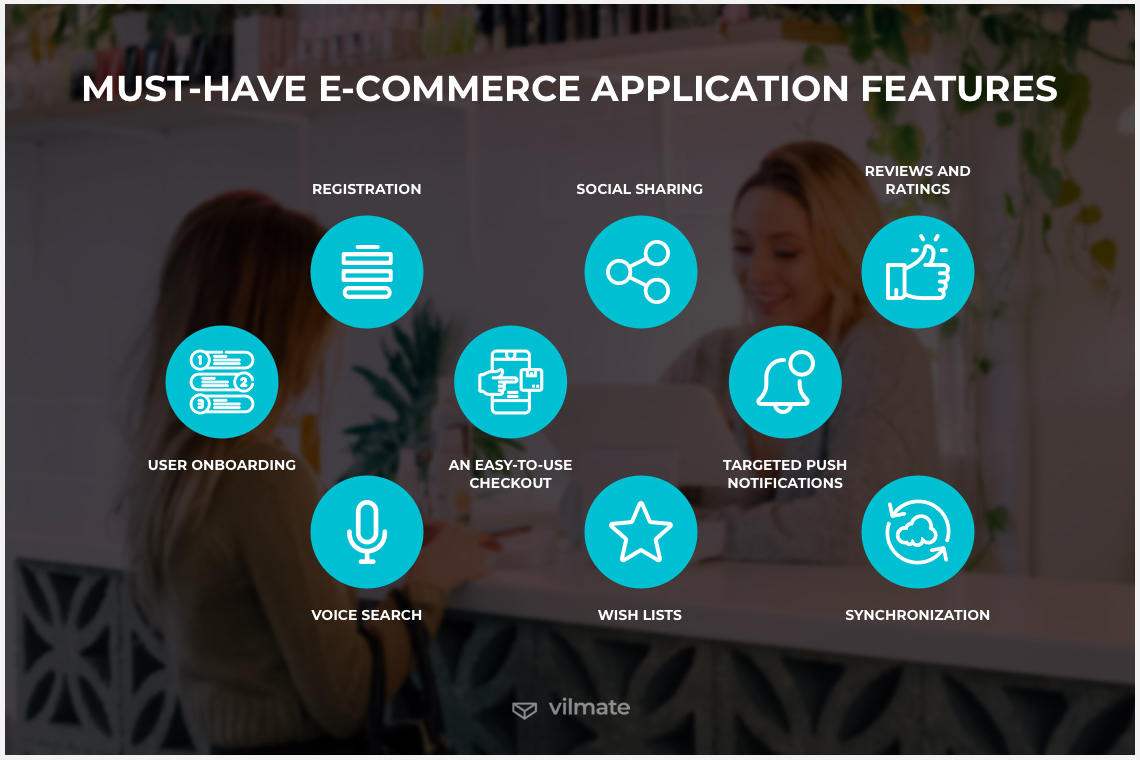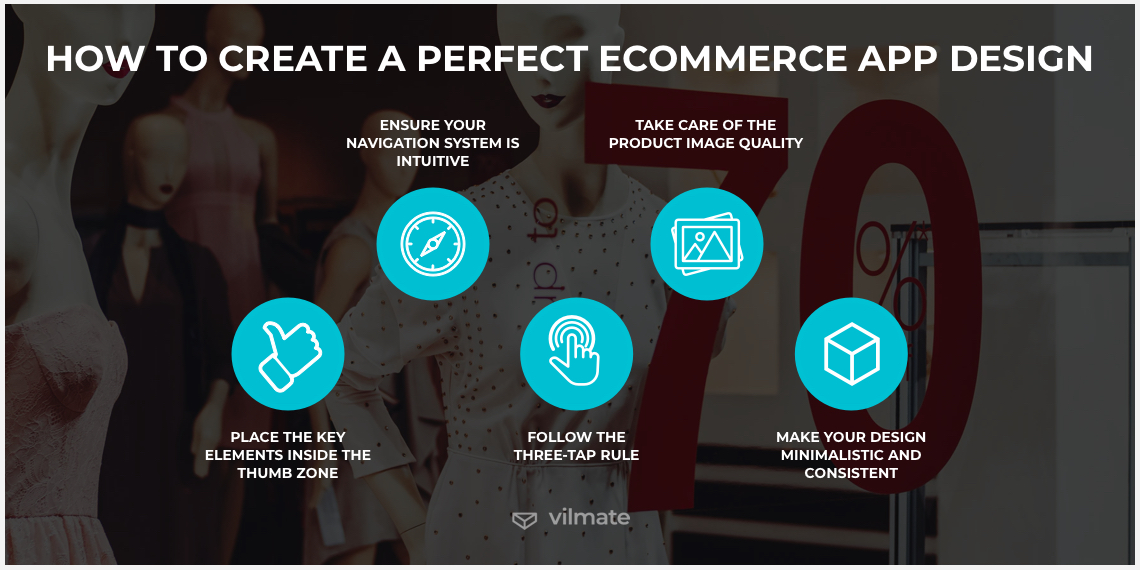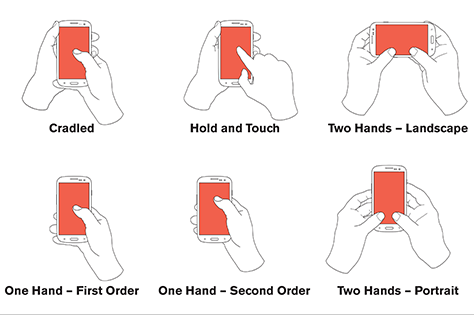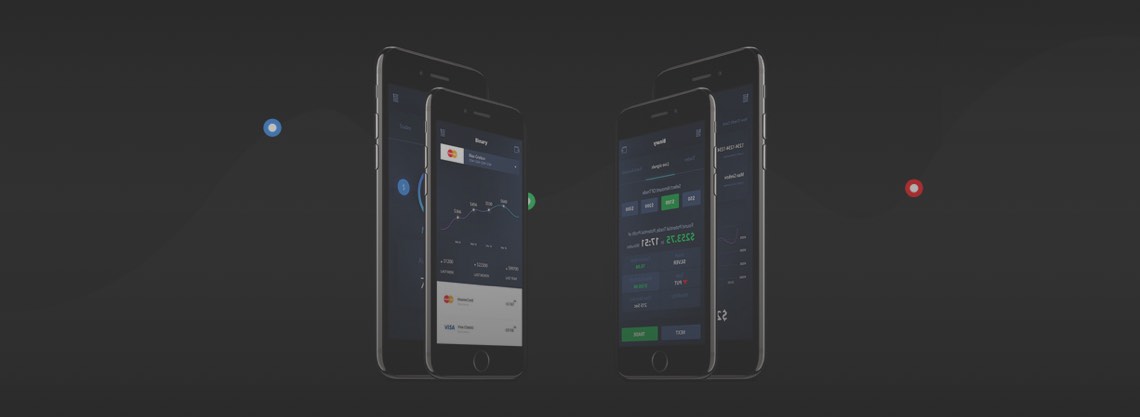E-commerce has dramatically changed the way people shop. Just in the last few years, e-commerce has exploded to lead the way in many consumer categories. Everything from food, clothing, and other accessories to electronics and cars can be purchased online. Not surprisingly, e-commerce is a cash cow for the world’s major online retailers. However, many young businesses wish to succeed in e-commerce, too. How to build an eCommerce mobile app? That is the question traders, marketers, store owners, and online retailers keep asking themselves as they explore the challenging market landscape.
Today, it is easier to create an eCommerce app than ever before. In this article, we list the best mobile eCommerce tools, discuss the e-commerce system architecture, and find out other essential details needed to understand what precisely an eCommerce app is and how to build one. So, what is the secret behind having a well-developed eCommerce mobile app that can allow you to sell online easily?
eCommerce applications and software development
A useful eCommerce application must be an engaging shopping environment for app users. When consumers are shopping online, they want to do it quickly and easily. So, as a business owner, you must not compromise on this. Ensuring a sleek and user-friendly mobile app for your eCommerce website or mobile app allows your store to function as an online marketplace in addition to a money-making vehicle.
Ensuring a seamless experience across your eCommerce platform, from creating a brand and building a brand image to taking online orders and working with suppliers and customers, will bring in new customers that you haven’t reached yet. So, these are the core principles you should follow to create a successful eCommerce app that its users would love:
- Ensure that all your stores are well organized, correctly displayed, and mobile-friendly;
- Convince customers to buy using your brand;
- Offer the best to date eCommerce solutions;
- Minimize the number of clicks that your users have to make an order;
- Promote your products by offering discounts, freebies, and more;
- Attract new customers by offering them great discounts;
- Provide consistent customer support;
- Emphasize the most in-depth and highest security level;
- Let your users manage their data and financial needs on their own;
- Promote your local competition by offering free shipping.
These principles are all effective for converting visitors into customers. However, it’s not enough to know them. To have any real lasting impact, you need to apply them in your business. So, let’s take a closer look at what makes an excellent eCommerce app functionality and design through which you’ll communicate to your customers.
Must-have e-commerce application features
App development requires close coordination between user experience design, product development, and sales team to make sure all goals are being met. The first and foremost component vital to the successful mobile eCommerce app development is application features.

The first thing to consider is the core functions that need to be provided in the app for users to reach their goals. By providing functionalities, including the following, you will give your eCommerce business a chance for a solid start:
1. User Onboarding. This is the first step of the setup, as it is the first feature needed to be present and operational. Make it non-intrusive and straightforward so that the user does not feel lost or confused. The user will like it when you show them that it is easy to sign up and complete the surveys or tasks. These instructions should help them understand and grasp the main functions of the app. Make the onboarding process fun and engaging.
2. Registration. This is a massive piece of the puzzle. Users have to register to get access to your application and start to make purchases. In order to keep your operations simple, all users should have an account, so once they’re logged in, they will have the option to customize their profile, complete the shopping cart, or use the payment-checkout function. We recommend making it as easy as possible to sign up for an account to speed up the entire process.
3. An easy-to-use checkout. Making the shopping cart functional can be complicated and confusing. Any kind of eCommerce business should not only be able to promote their products, but also provide an easy and clear way of shopping. Some of these requirements can be addressed in an e-commerce mobile app:
-
The check-out process. Navigating through the checkout will likely be the most common type of interaction for users when they visit your eCommerce app. A well-structured checkout process will ensure the customer spends little time checking out and comes back to your app with a positive experience, so integrating all the basic navigation processes will make your transaction experience that much more seamless. Providing basic redirects to your checkout will go a long way in making shopping for items easy for all.
-
Payment options. One of the most critical aspects of an eCommerce business is the payment options it offers users. Failing to provide payment options is a huge mistake that could leave your customers facing many problems. Setting up a payment gateway as part of an eCommerce solution, in this context, means being flexible in the payment options. Do this by giving users a choice of payment methods, not limiting them to only one. Then, provide an effective network integration for anyone who needs to make payments.
4. Social sharing. In most cases, social sharing is one of the most appealing features of an eCommerce app, so bring this feature to your product. The resulting interaction allows your customers to promote your product. In addition, this will help the users find their way to your app. If users are searching for your brand online, they will definitely find your eCommerce store.
5. Targeted push notifications. With a push notification service, your product information and sale details will be presented to your customers in a more timely manner. Moreover, product users will not have to log in with their email accounts every time they want to be notified. So, when your customer clicks on your push notification, he or she will be able to instantly see the product details on your eCommerce site, without having to search for it.
6. Reviews and ratings. Let your customers leave honest feedback about goods and services rendered via your eCommerce application. By encouraging users to leave customer reviews and rate an app, you will gain immense benefits in the form of improved trust and sales of your products. Also, leveraging the core functions to promote reviews and ratings, you can significantly increase sales, earn a better income, and ultimately improve the user experience.
7. Voice search. This is one of the biggest trends in app development now. Voice search feature can significantly improve the customer experience for your e-commerce app users. It enables them to find information that they are looking for quickly. Voice search in e-commerce is expected to cause a rise in sales, reaching a $40 billion rate by 2022, according to a recent study by OC&C Strategy Consultants. So, this eCommerce app feature is great and has a lot of potential that should not be ignored.
8. Wish lists. A wishlist is a collection of customers’ ordered items. By building and managing wishlists, you get a quick, easy way for consumers to get products they like. Besides, by enabling wishlists in their eCommerce apps for Android and iOS, stores allow customers to save and see their favorites, thus getting better insights into the needs of your clientele.
9. Synchronization. If there are both a mobile e-commerce application and a website, you need to make sure that the user can easily switch between the two to be able to complete their purchase. Synchronization will ensure that any user is getting the same product and experience, whether they are on a PC or their phone and tablet.
How to create a perfect eCommerce app design
E-commerce app design is as important as its feature set. UX/UI design of an app is all about understanding user behavior and helping them to achieve their objectives.
Basically, the guidelines for creating a flawless design for your own shopping app come down to an average of the recommendations mentioned above, yet somehow extended.

-
Place the key elements inside the thumb zone. This rule is important to keep in mind when designing an eCommerce application to boost its usability. The ways in which users hold their devices vary:
Source: Design for Fingers, Touch, and People, Part 1
However, the study claims that 75% of them do it using their thumb only. And by doing so, they prefer touching the center of the screen. As people tend to target this area, meet them halfway and place the principal UI elements inside the thumb zone to make the buying experience more pleasant for your customers.
-
Ensure your navigation system is intuitive. Another interesting observation is that navigation through your eCommerce app must be touch-friendly, too. Employ a three-piece layout that will consist of primary (a centerpiece with content and app’s functionality), secondary (actionable tabs along the edges moving to subsections,) and tertiary (more functions behind menus) sections. In other words, you should use standard elements, eCommerce app templates, and navigation patterns that people are used to, be it the tab bar for iOS or a navigation drawer for Android.
-
Follow the three-tap rule. Keep the structure of your eCommerce app clear. The three-tap rule will help you with that. To put it in a nutshell, the rule says that it has to take a user no more than three steps to make it to the sought-for product. Thus, the suggested order is the following: categories - subcategories - products. It doesn’t mean, however, that it must be the only way to find the product. The search bar can help reduce the number of steps to complete before checking out, which is great. To serve its purpose well, the bar has to be noticeable, offering users query-autocomplete and filtering functionality.
-
Take care of the product image quality. It has to be easy for users to view product images and get to know what the product is and how it works. The product image quality and the number of photos that you share must meet the users’ expectations. Displaying high-resolution pictures of goods, you give users the ability to compare the benefits of your products with the competition before they make their purchases. Besides, quality pictures can communicate your product value and make your customers feel confident and satisfied with what they have obtained as a result.
-
Make your design minimalistic and consistent. The simpler, the better. When you decide to build an eCommerce app, remember that a minimalist user interface is one of the most critical aspects of your application that will definitely result in snappier customer experience.
Think about your first-time users when creating UI design for your shopping app. If they feel confused with the multiplicity of unordered UI elements, lots of bright colors, and the lack of consistency in the app design, chances are they won’t come back. Material Design helps find the answer to how to make an eCommerce app in Android Studio and ensure its design looks native. Human Interface Guidelines do the same for iOS.
The best eCommerce apps
As you can see, there are some e-commerce app requirements and recommendations that are aimed to make your application great. Following them can boost your chances of creating a useful and enjoyable application. However, it’s also a good idea to take a look at your competition, the best eCommerce apps that have already won users’ trust. To give you a vivid picture of different types of successful e-commerce applications, we won’t focus exclusively on the world's leading online shopping retail companies like Amazon, eBay, AliExpress, or Alibaba. Let’s take a look at an existing wide variety of options.
1. Amazon. No list of successful shopping apps would be complete without Amazon. Launched as an online bookstore, it now offers splendid user experience as a retail outlet both via a web browser and mobile app. On the Apple App Store, it is number one in the Shopping category by downloads globally.
Available in a large variety of languages, it is one of the world's most serviceable digital libraries for goods. Amazon's product database is regularly updated with a vast selection of categories and subject categories. Plenty of useful subcategories have been created to enable users to choose the ones that can help them find what they are looking for.
2. Walmart. In 2019, Walmart’s eCommerce strategy began paying off. An American retail corporation has made some acquisitions and partnerships that helped attract and engage new shoppers, its cooperation with Google being one of the most successful deals.
The recent holiday season showed that Walmart has something interesting to offer to customers in the US. Its eCommerce app became the most-installed shopping app on the U.S. App Store. Now, Walmart continues upgrading its mobile apps to meet clients' needs and showcase the benefits of Walmart’s mobile applications.
3. Adidas. The largest sportswear manufacturer in Europe, Adidas, now employs its mobile apps to reach its goals for e-commerce sales. Adidas Shop & Style is an app that uses AI to get to know its users better. It can adapt itself to offer customers highly personalized content they actually want to see.
The app layout is set out clearly, so browsing through the pages takes no extra effort and the check-out process is smooth and frustration-free. This mobile eCommerce app became a win-win for Adidas, as they managed to set up their own distribution channel that is getting more and more profitable each year.
The eCommerce app development cost estimates
In view of everything that has been said above, getting a readymade eCommerce app is not a good idea. In order to become popular among the clientele, an app must create personalized experiences for its customers.
So, the eCommerce app development cost is another thing to consider.
It is recommended to opt for native app development instead of going for a hybrid solution when it comes to mobile eCommerce. Then, your project team will consist of UI/UX designers, iOS and Android developers, testers and Q&A engineers. Optionally, you can extend a team to include a project manager and full-stack web developers.
There are basic, standard, and complex versions that would differ in how advanced the functionality of an eCommerce app is and in the level of the subsequent tech support needed. Some other factors may also affect the total price. Thus, you need to decide if you want to make an MVP first and if you’re going to develop apps for iOS and Android operating systems simultaneously or one at a time. Besides, you should establish if you’d like to outsource app development or create an app hiring software engineers on-site, and more. Now, let’s take a look at how much it may cost you to develop a native eCommerce app for Android and iOS.
| Native iOS app | Native Android app | |
| Basic app development | $35,000 | $30,000 |
| A medium-complexity app | $50,000 | $50,000 |
| Complex app development | $100,000+ | $90,000+ |
That’s approximate estimates. Remember that the best Agile and DevOps practices may help you reduce the development cost. Besides, you are always free to contact us if you need more information or still have some questions about how to build an eCommerce mobile app and manage to avoid overheads.
Conclusion
People are getting more inclined to buy things online, so if you have an idea to build an eCommerce app and make their lives easier, then go ahead! You should only keep in mind that the competition in the eCommerce market is becoming closer, so providing unique personalized experiences to users and making online shopping as seamless as possible for them is a must. We hope our findings will help you build your eCommerce strategy wisely and sort out priorities before you start your journey.

© 2020, Vilmate LLC





